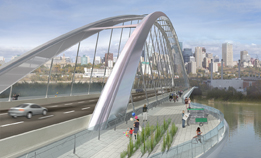Lesson 5
1. Lesson 5
Module 4: Quadratic Equations and Inequalities
Lesson 5: Solving Quadratic Systems Graphically
Focus

Courtesy City of Edmonton/Dialog. Reproduced with permission.
The illustration to the right shows what the Walterdale Bridge, which spans the North Saskatchewan River in Edmonton, might look like when the existing bridge is replaced. Notice that the arches resemble parabolas and that the supports resemble lines. Do the arches intersect? Where do the supports and arches intersect?
Previously in this module you used the graphs of quadratic functions to solve quadratic equations. In this lesson you will study systems of linear-quadratic and quadratic-quadratic equations. Just as you did with the illustration, you will focus on where lines and parabolas intersect. You will also discover the use of multiple parabolas in the design of buildings and other structures.
Outcomes
At the end of this lesson you will be able to
- explain the meaning of the points of intersection of a system of linear-quadratic or quadratic-quadratic equations
- explain, using examples, why a system of linear-quadratic or quadratic-quadratic equations may have zero, one, two, or an infinite number of solutions
- determine and verify the solution of a system of linear-quadratic or quadratic-quadratic equations graphically, with technology
- relate a system of linear-quadratic or quadratic-quadratic equations to the context of a given problem
- model a situation using a system of linear-quadratic or quadratic-quadratic equations
Lesson Questions
You will investigate the following questions:
- Why are the points of intersection of a system of equations related to its solution?
- How does a graphical representation facilitate mathematical understanding?
Assessment
Your assessment may be based on a combination of the following tasks:
- completion of the Lesson 5 Assignment (Download the Lesson 5 Assignment and save it in your course folder now.)
- course folder submissions from Try This and Share activities
- additions to Module 4 Glossary Terms and Formula Sheet
- work under Project Connection
Materials and Equipment
You will need the following to complete the optional Math Lab in the Going Beyond section:
- two small objects of similar size and weight (e.g., tennis balls, toy cars, whiteboard brushes)
- a flat elevated surface that is at least 1 m in length (e.g., table top, whiteboard ledge)